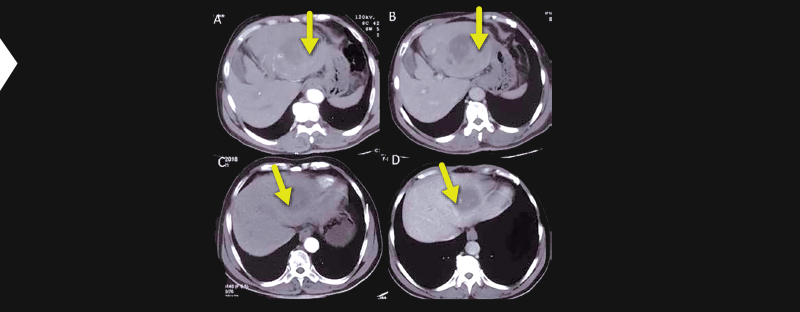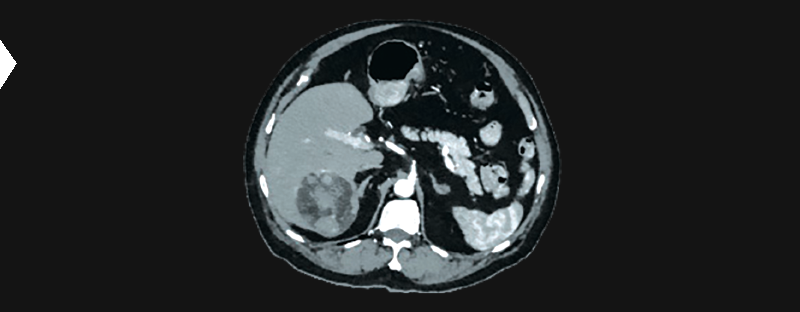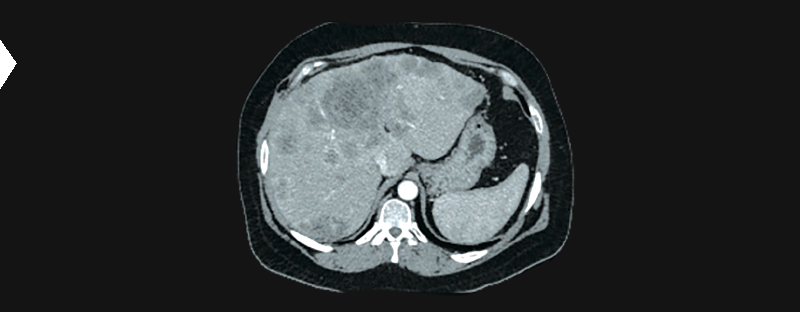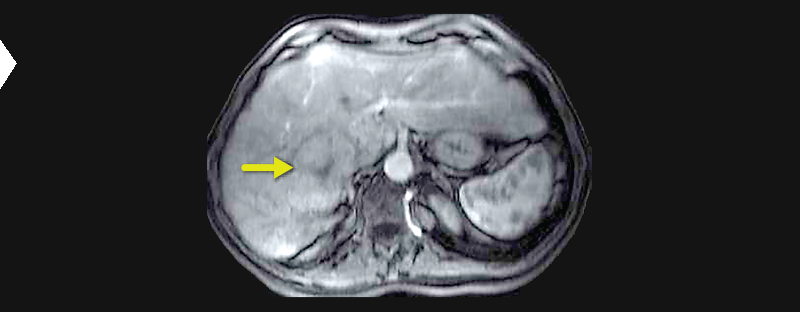A complex patient profile can include:
Both Clinical and Real World Evidence (RWE) support use of Pressure-Enabled Drug Delivery™ (PEDD™) in complex patients.1-4
Clinical
Multiple studies of different therapeutics make up a growing body of evidence that supports how TriNav’s PEDD approach can increase the T:N ratio and improve patient outcomes.2-4
RWE
A comprehensive RWE study of PEDD for TACE and TARE among patients with HCC and liver metastases demonstrated that despite higher baseline disease burden and complexity, patient outcomes were similar for non-PEDD patients.1
Previously embolized tumors can be more difficult to visualize and penetrate due to regions of necrosis and damaged vasculature.5

Residual disease following TACE6
Lack of particle penetration may be the cause of poor response to embolization in patients with large (>5 cm) tumors.7

Pre-treatment CT showing 7×6 cm biopsy proven HCC in segment 6/78
It can be difficult to deliver adequate treatment while minimizing injury to normal liver in patients with multiple tumors.9

Multi-focal, poorly differentiated cholangiocarcinoma10
In patients with borderline liver function, the challenge is to deliver an effective treatment while preserving adequate healthy liver tissue.11
Elevated liver biomarkers are associated with poor prognosis in HCC.12

Typical HCC in a patient with chronic hepatitis C.13
It can be challenging to achieve adequate particle penetration into hypovascular tumors.14

Metastatic renal cell carcinoma, with hypovascular liver metastases15
* Tumor to normal
References
1. Cook K, Gupta D, Liu Y, et al. Real-world evidence of pressure-enabled drug delivery for trans-arterial chemoembolization and radioembolization among patients with hepatocellular carcinoma and liver metastases. Curr Med Res Opin. 2024;40(4):591-598.
2. Titano JJ, Fischman AM, Cherian A, et al. End-hole versus microvalve infusion catheters in patients undergoing drug-eluting microspheres–TACE for solitary hepatocellular carcinoma tumors: a retrospective analysis. Cardiovasc Intervent Radiol. 2019;42(4):560-568.
3. d’Abadie P, Walrand S, Goffette P, et al. Antireflux catheter improves tumor targeting in liver radioembolization with resin microspheres. Diagn Interv Radiol. 2021;27(6):768-773.
4. Pasciak AS, McElmurray JH, Bourgeois AC, Heidel RE, Bradley YC. The impact of an antireflux catheter on target volume particulate distribution in liver-directed embolotherapy: a pilot study. J Vasc Interv Radiol. 2015;26(5):660-669.
5. Chen S, Peng Z, Zhang Y, et al. Lack of response to transarterial chemoembolization for intermediate-stage hepatocellular carcinoma: abandon or repeat? Radiology. 2021;298(3):680-692.
6. Gupta P, Kalra N, Gulati A, et al. Response assessment following image-guided therapy of hepatocellular carcinoma. J Clin Interv Radiol ISVIR. 2020;4(02):088-097.
7. Higuchi T, Kikuchi M, Okazaki M. Hepatocellular carcinoma after transcatheter hepatic arterial embolization. A histopathologic study of 84 resected cases. Cancer. 1994;73(9):2259-2267.
8. Representative image: Case Presentation – Right Hepatic Glass Y90 Treatment Using Trinav (MKT-0068)
9. Tomozawa Y, Jahangiri Y, Pathak P, et al. Long-term toxicity after transarterial radioembolization with yttrium-90 using resin microspheres for neuroendocrine tumor liver metastases. J Vasc Interv Radiol. 2018;29(6):858-865.
10. Representative image: Case Presentation – Precision and Accuracy of The TriNav Infusion System (MKT-0326)
11. Jeschke M, Ludwig JM, Leyh C, et al. Bilobar radioembolization carries the risk of radioembolization-induced liver disease in the treatment of advanced hepatocellular carcinoma: safety and efficacy comparison to systemic therapy with atezolizumab/bevacizumab. Cancers (Basel). 2023;15(17):4274.
12. Wang F, Gao S, Wu M, et al. The prognostic role of the AST/ALT ratio in hepatocellular carcinoma patients receiving thermal ablation combined with simultaneous TACE. BMC Gastroenterol. 2023;23(1):80.
13. Ramalho M, Matos AP, AlObaidy M, Velloni F, Altun E, Semelka RC. Magnetic resonance imaging of the cirrhotic liver: diagnosis of hepatocellular carcinoma and evaluation of response to treatment – Part 1. Radiol Bras. 2017;50(1):38-47.
14. Wasan HS, Gibbs P, Sharma NK, et al. First-line selective internal radiotherapy plus chemotherapy versus chemotherapy alone in patients with liver metastases from colorectal cancer (FOXFIRE, SIRFLOX, and FOXFIRE-Global): a combined analysis of three multicentre, randomised, phase 3 trials. Lancet Oncol. 2017;18(9):1159-1171.
15. Representative image: Imaging Library – Improved Infusion with TriNav (MKT-0339)
